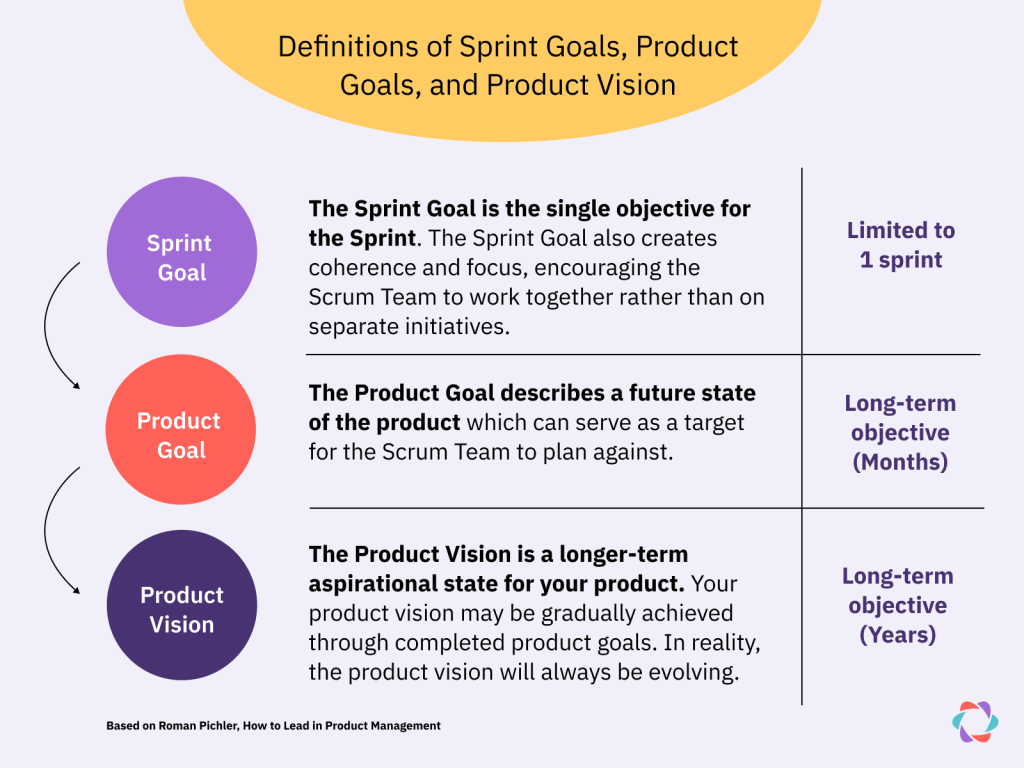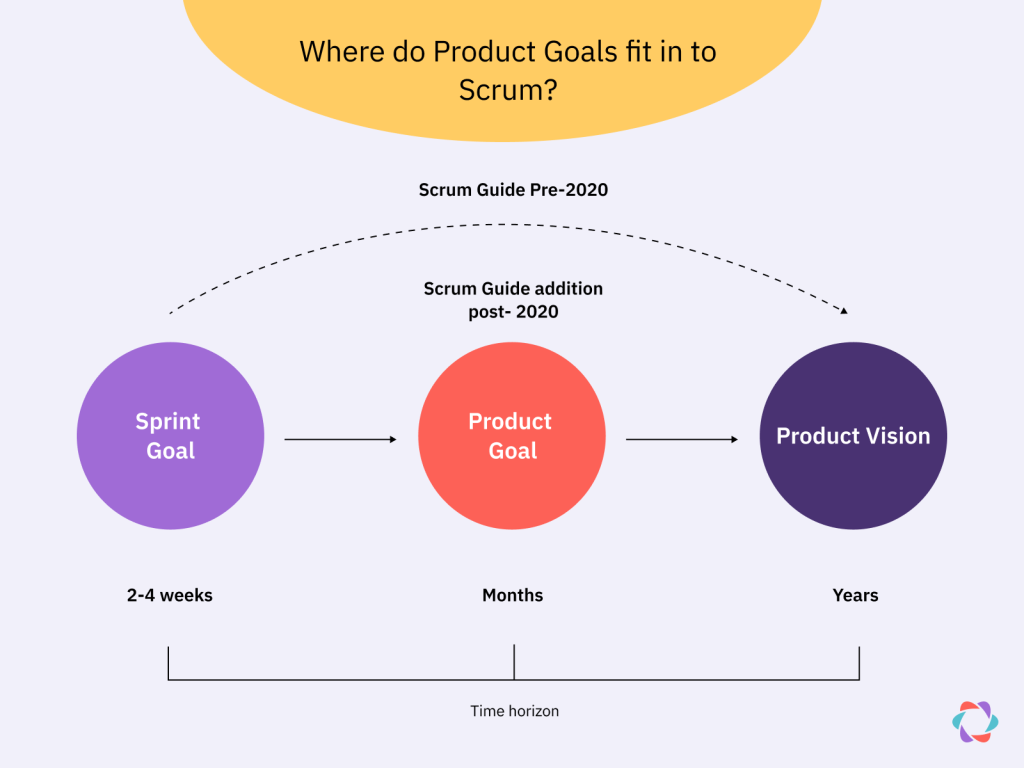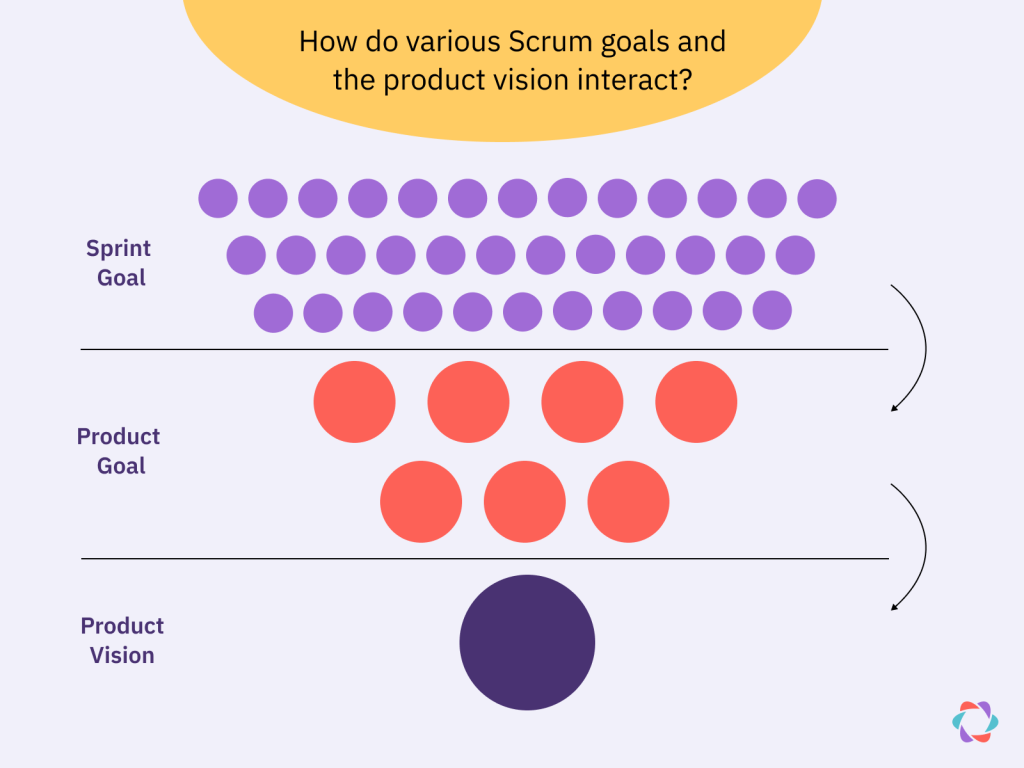Product Goals: How to Write and Use Them

Product goals may be one of the most obscure parts of the Scrum framework. Some confusion with Scrum terminology is unforgivable in Agile circles – like mixing up Agile and Scrum.
But everyone will forgive you if you have:
- Never heard of the Product Goal.
- Think it’s the same as a product vision.
- Wonder how it’s different from the Sprint Goal.
That’s because the term “Product Goal” is relatively new in Scrum.
Product Goals only made an appearance in the latest 2020 edition of the Scrum Guide to give teams a new perspective. Product Goals are an objective that’s further off than short-term Sprint Goals but closer and more concrete than the elusive product vision.
This article explains everything you need to know about Product Goals, with tips on how to write one, examples, and a handy checklist.
What is a Product Goal in Scrum?
A Product Goal is a measurable and actionable target describing what the Scrum Team aims to build in the months ahead and for what purpose. It acts as a bridge between the product vision – which is very long-term and somewhat vague – and a team’s short-term Sprint Goals.
The Product Goal describes a future state of the product which can serve as a target for the Scrum Team to plan against. The Product Goal is in the Product Backlog. The rest of the Product Backlog emerges to define “what” will fulfill the Product Goal.
The Scrum Guide
A Product Goal goal can be deconstructed as follows:
- Do something for the user and/or business with this purpose.
An example of a Product Goal may be to “improve onboarding to increase conversions” or “overhaul the online shopping experience to increase revenue.”
Here’s what this looks like with an example from our work at Parabol:
- 🎯 Product Goal: Create a feature that enables users to run async-first daily standups in Parabol to increase our total user base
- 🎁 Epic: Build prototype daily standups logic and structure [Part of feature]
- 📦 Task: Build logic for starting new meeting [Contribution to part of feature]
The Scrum Team uses a Product Goal to plan, prioritize, and focus their work. Members of the team should add the Product Goal to the top of the Product Backlog, just like you may state a Sprint Goal at the top of the Sprint Backlog.

By completing items in the Product Backlog, Scrum teams should eventually fulfill the Product Goal. Just as completing items in the Sprint Backlog helps teams achieve their Sprint Goal.
A team can only have one Product Goal at a time and it usually spans a few months, though the Scrum Guide doesn’t prescribe a specific length or timebox.
Who writes Product Goals in a Scrum team?
The Product Owner writes the Product Goals for a Scrum team. Writing Product Goals fits with the Product Owner’s overall responsibility for the direction of the product. The Product Owner will usually consult other stakeholders in the business before confirming Product Goals with other members of the Scrum team.
Why are Product Goals helpful for Scrum teams?
Setting Product Goals helps Scrum Teams:
- 🔍 Create an objective that’s clear, measurable, and not too far off that brings you closer to fulfilling your product vision.
- 💬 Inform stakeholders about the product’s expected evolution simply by sharing a list of the planned, upcoming Product Goals, instead of having to share and explain the entire product roadmap.
- 🏎️ Focus and streamline Product Backlog refinement by encouraging teams to prioritize Product Backlog items that help meet the Product Goal and deprioritizing those that do not. This helps ensure the right product gets built.
- 🤝 Align Sprint Goals more easily with your long-term product vision.

Product Goal vs. Sprint Goal: What’s the difference?
A Product Goal is to the Product Backlog what a Sprint Goal is to the Sprint Backlog.
The Product Goal gives guidance on which items to place, refine, and prioritize in the Product Backlog. The Sprint Goal does the same, but in a shorter time frame – one Sprint.

Product Goal vs. Epic: What’s the difference?
The main difference between epics and Product Goals are that Product Goals:
- Emphasize the purpose of the objective
- Are less specific about the what and how of the work
- Are usually larger in scope than epics
For example, a cluster of epics might contribute to achieving a Product Goal.
How to write an effective Product Goal
We suggest following these steps to craft effective Product Goals.
1. Consider the product vision, user needs, and business goals
Besides your long-term product vision, user needs and business objectives should inform your Product Goal. Thinking about this triad of variables helps make sure you’re building a product people want.
2. Explain what you want to achieve, not how
As with a good user story, product owners shouldn’t dictate how the team should achieve their goal. That’s up to them to figure out.
However, you do want to explain what they need to achieve.
“Give the user access to every conceivable organic recipe from any device instantly” is a valid Product Goal for a cooking community platform.
Stating that you want “a recipe search function with filters for cuisines and ingredients” is too specific, at least for a Product Goal.
3. Gather input on your draft goal
Once you have a draft Product Goal, see if there’s more data or information to help improve it. You want to verify that it’s the best objective for the given moment.
You can gather such information from existing product usage data or even market research and industry reports to validate whether there’s a need for what you’re thinking of building.
Make sure to run the draft goal by your team members and other knowledgeable folks for feedback to refine and finish it. Your Product Goal shouldn’t be a secret you unveil at the last minute, but something you’ve shaped over time with the team and other stakeholders.
4. Make the goal measurable
The new Scrum Guide from 2022 doesn’t say anything about Product Goal metrics, but we recommend connecting at least some metrics to your Product Goal. This will make it measurable.
With metrics, it’s clear to the team when they have reached their objective. It also allows the product owner to track progress along the way.
Say your Product Goal is to “help users have better online retrospectives so they’ll use our product more,” then session length and weekly retention could be helpful KPIs to set and track along with your goal.
5. Inspire realistic ambition
Besides giving the team a clear target to work toward, the Product Goal should inspire ambition and motivate team members to push beyond what they thought possible.
The Product Goal should also be achievable. When the goal is impossible, you set the team up for failure and achieve the opposite effect: a demotivated Scrum Team.
Getting this balance right is a bit of an art. But if your team already has an agile mindset of continuous improvement and is intrinsically motivated, they’ll want a somewhat ambitious goal and will help you craft one. If they don’t, you have bigger worries than getting your Product Goal right.
What are some Product Goal examples?
When looking at Product Goal examples, it’s helpful to compare them to the product vision and Sprint Goals that go along with them. That way, you can see the differences and relations between them.
A good Product Goal example ✅
Product management expert Roman Pichler provides one of the best Product Goal examples:
- Product vision: Help people eat healthily.
- User and Business Goal: Reduce the risk of developing type-two diabetes.
- Product Goal: Help the users understand their eating habits and acquire an initial user base.
- Sprint Goal: Validate that users are willing to share personal information when activating the app.
His Product Goal is more specific than the product vision and gives direction. At the same time, it doesn’t say how to achieve the objective, which would make it more like a task or epic (a large task or user story).
A flawed Product Goal example ❌
Simon Kneafsey, a Professional Scrum Trainer with Scrum.org and TheScrumMaster.co.uk, also provides a Product Goal sample using the case of a fictional bakery:
- Product vision: Be the leading online Bakery in the UK.
- Product Goal: Launch a website that allows sales to customers inside London.
- Sprint Goal 1: Create basic website structure.
- Sprint Goal 2: Build capability to list & purchase products using a credit card.
- Sprint Goal 3 and beyond: As many more Sprint Goals as needed.
- Final Sprint Goal: Launch the website and fulfill the first orders.
While Simon’s example is valid, it’s hard to see the difference between his Product Goal and a regular project milestone or epic. His goal arguably veers too much into prescribing how to achieve the objective instead of inspiring ambition by only giving a what and why.
What are common best practices for Product Goals?
Here are a few pointers and best practices for when and how to use your well-crafted Product Goal to the greatest effect.
Your Product Goal should be used as a:
- 🎯 Singular goal: A Scrum Team can only have one Product Goal that they need to complete or abandon before moving onto another.
- ☕ Filter: The Product Owner can use the Product Goal during Product Backlog refinement to prioritize or even filter out Product Backlog items.
- ⭐ North Star: Keeping the Product Goal visible during Sprints helps teams connect with their longer-term objective and purpose instead of only fixating on the current Sprint Goal.
- 📏 Yardstick: The Product Goal is a practical focal point for Sprint Review meetings. Product Owners and the rest of the Scrum team can use it to determine and discuss whether previous Sprints are pushing towards the goal
Product Goal template and checklist
A Product Goal must be a straightforward statement that the entire team understands. Essentially it says:
Do something for the user and/or business with this purpose.
To ensure your Product Goal is ready to go, ask yourself these product goal questions”
- Does completing your goal bring you closer to your product vision? How?
- Does your objective serve a user or business need? Which one?
- Is your Product Goal concise, meaning one or two sentences at most?
- Which metrics will you use to measure the progress and success of your goal?
- Have the team and stakeholders provided feedback on the draft goal to improve it?
- Which data or other input convinces you this is the best possible Product Goal to pursue at the current moment?
If the answer to any of these questions is “no” or “I don’t know,” then revisit your Product Goal. Keep calm and carry on crafting. Take your draft to the team and discuss the issues you found through the checklist above – together, you’ll arrive at a perfect Product Goal. 💪
Product Goals infographic
Here’s a handy infographic that covers everything you need to know about Product Goals in one place. Consider sharing it with your team or your network if you find it helpful! This infographic summarizes this blog in an easily digestible way.










